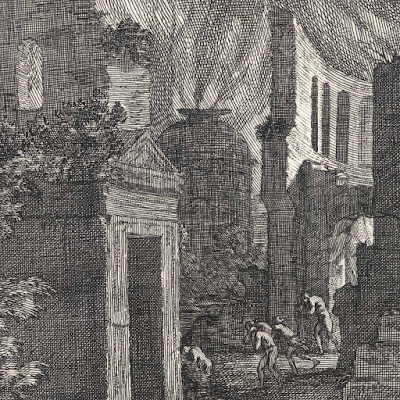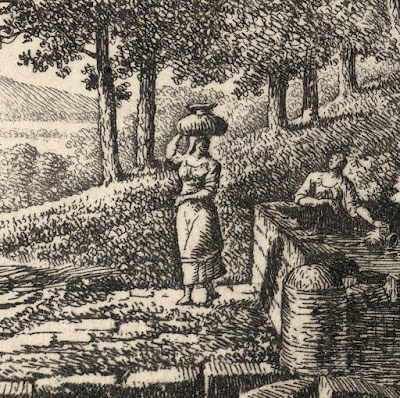Jan Saenredam (c1565–1607)
“Elisha Taking the Cloak of Elijah, who
Ascends to Heaven in a Chariot of Fire” (TIB title), 1604, from the series “Prophets
Ahias and Elijah” after Abraham Bloemaert (aka Abraham Bloemaart) (1564–1651),
published by Jan Saenredam and with Latin verses by Theodorus Schrevelius (1572–1649/53).
Engraving on fine laid paper with "Adler" watermark at the upper edge,
trimmed unevenly along the image borderline and slightly within the borderline
at top and backed with a support sheet.
Size: (sheet) 27 x 19.5 cm
Inscribed on plate within the lower image
borderline: (right of centre) "A. Bloemaert inuen, / J. Saenredam Sculp, 4"
Lettered on plate below the image
borderline in two columns of two lines of Latin text: "Helias, ...
tendit".
State ii (of iii) Note that the BM holds
a copy with the plate numbered “2” (D,7.89) but no information is given
regarding the state number in the references. This impression and the second
state impression held by the Rijksmuseum (RP-P-H-M-12) show the plate numbered “4”,
consequently I assume that this impression is from the second state as I can
see no differences in both impressions, but I do not have information regarding
changes to the plate made in the third state to confirm my attribution.
TIB Bartsch 4 (3 [Part 2).23 (227) (Walter
L Strauss [ed.) 1980, “The Illustrated Bartsch: Netherlandish Artists”, vol. 4,
p. 332); Bartsch (1803) III.226.23 (Note that this ref. to Bartsch is made by
the BM but I believe it may be wrong and the true number is III.227.23) (Bartsch,
Adam, “Le Peintre graveur”, 21 vols, Vienna, 1803); Hollstein Dutch 15-2(3) (Hollstein,
F W H 1949, “Dutch and Flemish etchings, engravings and woodcuts c.1450-1700”,
Amsterdam); Roethlisberger 1993 82 (Marcel G Roethlisberger 1993, “Abraham
Bloemaert and his Sons: Paintings and Prints”, 2 vols, Ghent)
The British Museum offers the following
description of this print:
“Elisha and Elijah's chariot of fire;
Elisha kneels and reaches towards the sky towards a chariot ascending to heaven
and a cloak that falls to the ground (2 Kings 2:11); after Bloemaert”
See also the description of this print
offered by the Rijksmuseum:
(transl.) “The prophet Elisha in the
foreground. He kneels and looks in disbelief at Elijah, who is led to heaven in
a fiery chariot. Elia's coat falls out of the car[t]. The print has a Latin
text in the bottom margin.”
Condition: well-inked and near faultless
impression in excellent condition (i.e. there are no tears, holes, creases, abrasions,
stains or foxing) trimmed unevenly around the image borderline and backed with
a support sheet of archival (millennium quality) washi paper.
I am selling this exceedingly rare engraving
of exceptional quality and elegant beauty for the total cost of AU$434
(currently US$318.67/EUR275.49/GBP244.09 at the time of posting this print)
including postage and handling to anywhere in the world (but not, of course,
any import duties/taxes imposed by some countries).
If you are interested in purchasing this
major engraving of the highest level of technical brilliance, please contact me
(oz_jim@printsandprinciples.com) and I will send you a PayPal invoice to make
the payment easy.
This print has been sold
I guess that I should not have been
surprised when I “Googled” the translation of the title of this engraving from
a non-English speaking dealer to find that I was looking at “Elias and the fire
truck”. Heavens to Betsy! Of course, what is portrayed in this scene is not a
fire truck in the sky at all but a heaven-sent chariot ablaze with fire.
For those like me who happily skipped on
Bible studies, the following verse from the Old Testament (2 Kings 2:11 [NIV, 1973]) reveals what this engraving illustrates:
“As they [Elisha and Elijah] were
walking along and talking together, suddenly a chariot of fire and horses of
fire appeared and separated the two of them, and Elijah went up to heaven in a
whirlwind.”
To give a brief version of my understanding
of the rest of the story, the cloak/mantle shown dropping from the chariot
holding Elijah is later picked up by Elisha—the figure on the ground with
outstretched hands—and from the cloak he acquires the ability to perform
miracles. (I apologise if my account of this event is flawed.)
For those interested in this episode,
the scene was later portrayed in woodcuts by Julius Schnorr von Carolsfeld (1794–1872); see
https://commons.marymount.edu/en204fa13/wp-content/uploads/sites/85/2013/08/Chariots.jpg
and http://www.marysrosaries.com/collaboration/index.php?title=File:Vision_of_the_Prophet_Ezekiel_-_Bible_Ezechiel.JPG.
More famously, William Blake also illustrated his vision of the chariot of fire
in the technically fascinating relief etching (with watercolour), “God Judging
Adam”, 1795; see http://www.tate.org.uk/art/artworks/blake-god-judging-adam-n05063
















































